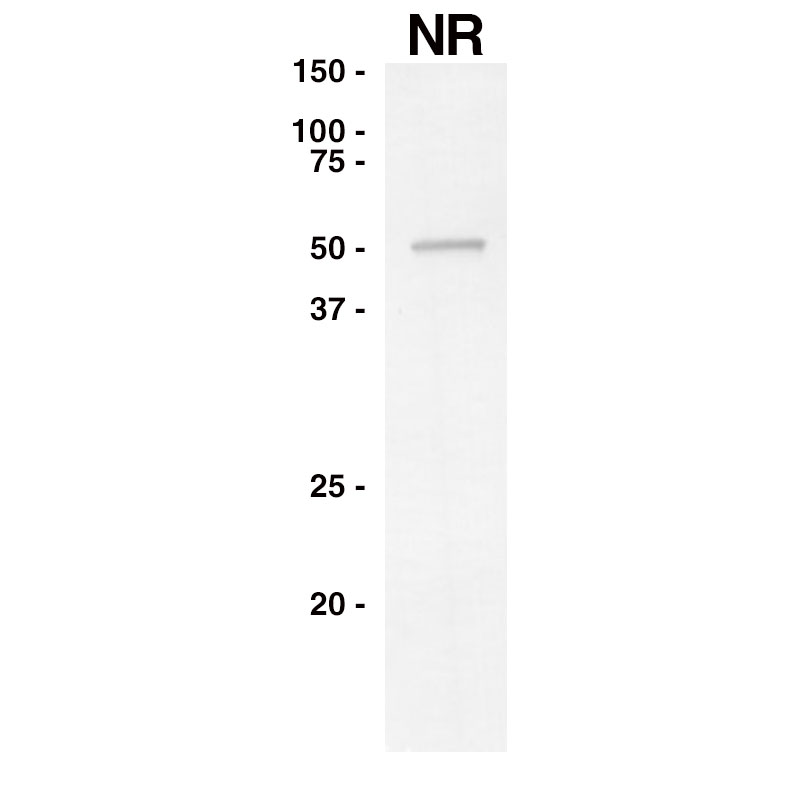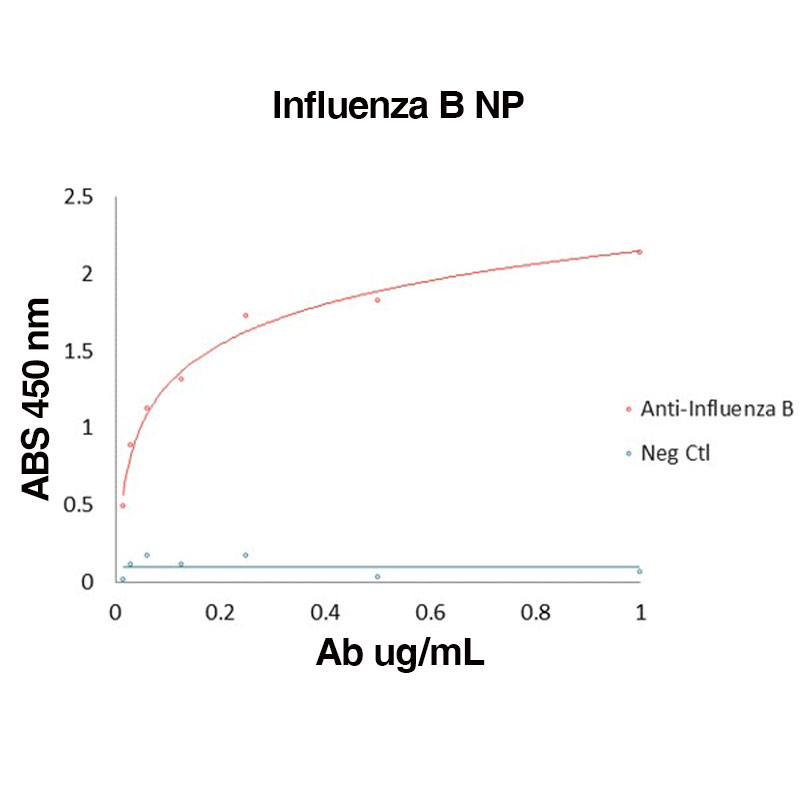Anti-Influenza B, NP (IB-1837)
Anti-Influenza B, NP (IB-1837)
Product No.: F658
- -
- -
Clone IB-1837 Formats AvailableView All Product Type Hybridoma Monoclonal Antibody Alternate Names Influenza B Virus NP, NP, Nucleocapsid protein, Nucleoprotein Isotype Mouse IgG Applications ELISA , FC , IF , IP , WB |
Data
 Western Blot
Western Blot
Purified Recombinant Influenza B NP (Leinco Prod. No.: F650) was separated on SDS PAGE under reducing conditions and probed with an anti-Influenza B NP antibody (Leinco Prod. No.: F658).
 Direct binding of anti-Influenza B NP Antibody (Leinco Prod. No.: F658) to Influenza B NP (Leinco Prod. No.: F650).
Direct binding of anti-Influenza B NP Antibody (Leinco Prod. No.: F658) to Influenza B NP (Leinco Prod. No.: F650).
Influenza B NP was immobilized at 1 µg/mL. Anti-Influenza B NP antibody was titrated.
- -
- -
Antibody DetailsProduct DetailsReactive Species Influenza B Virus Host Species Mouse Immunogen Influenza B NP Product Concentration ≥1.0 mg/ml Purity ≥90% monomer by analytical SEC and SDS-Page Formulation Formulated in 0.01 M phosphate buffered saline, pH 7.2 and contains 0.1% sodium azide. Due to inherent biochemical properties of antibodies, certain products may be prone to precipitation over time. Precipitation may be removed by aseptic centrifugation and/or filtration. State of Matter Liquid Product Preparation Hollow fiber bioreactor using fetal bovine serum of US origin. Purified using Protein A affinity chromatography. Storage and Handling This antibody may be stored sterile as received at 2-8°C for up to one month. For longer term storage, aseptically aliquot in working volumes without diluting and store at -80°C. Avoid Repeated Freeze Thaw Cycles. Regulatory Status Research Use Only Country of Origin USA Shipping 2-8°C Wet Ice Applications and Recommended Usage? Quality Tested by Leinco ELISA, WB Additional Applications Reported In Literature ? IF, IP, FC Each investigator should determine their own optimal working dilution for specific applications. See directions on lot specific datasheets, as information may periodically change. DescriptionDescriptionSpecificity Influenza B NP Background There are four types of Influenza (flu) viruses: type A, B, C, and D. Influenza A and B viruses are routinely spread in people and other mammals, while also known for seasonal flu epidemics each year. Influenza B is a Betainfluenzavirus in the virus family Orthomyxoviridae. Influenza B is classified into two distinct lineages, B/Victoria and B/Yamagata1. Influenza B can be even further classified into specific clades (also known as groups) and sub-clades (also known as sub-groups) based on similarity of their HA/NA gene sequences1.
The Nucleocapsid protein or nucleoprotein (NP) of influenza virus B negative-strand RNA’s primary function is to encapsulate the virus genome for the purpose of RNA transcription, replication and packaging2. Specifically, NP is the most abundant viral protein in infected cells2, therefore the NP can be and has been used for anti-influenza drug development3 The NP of influenza A and B viruses share up to 38% of their amino acid sequence, indicating region functionality differences at the amino acid level4. Ligand/Receptor Ligand UniProt.org Research Area Immunology . Infectious Disease . Seasonal and Respiratory Infections . Viral . IVD Raw Material References & Citations1. Types of Influenza viruses (2019) Center for Disease Control and Prevention.
2. Hu Y, Sneyd H, et al. (2017) Curr Top med Chem. 2017; 17(20): 2271–2285. 3. Portela A, Digard P. (2012) J. Gen Virol. 2002 Apr;83(Pt 4):723-734. 4. Sherry L, Smith M, et al. (2014) Journal of Virology. 2014; 88(21); 12326-12338. DOI https://doi.org/10.1128/JVI.01542-14 Technical ProtocolsCertificate of Analysis |


